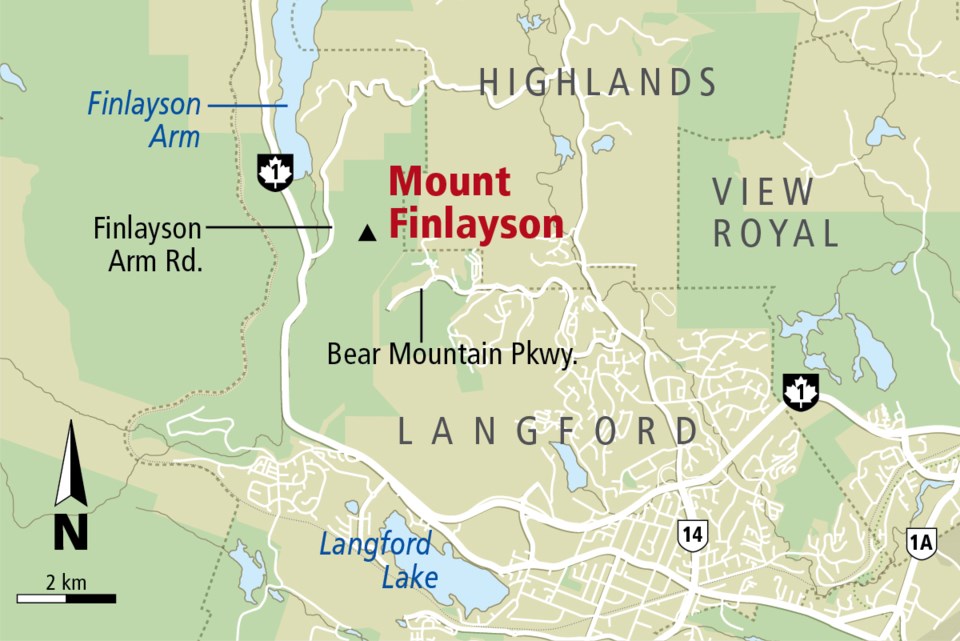Langford firefighters and B.C. Ambulance paramedics received additional assistance from the air Saturday when they searched, located and rescued an injured hiker off Mount Finlayson.
Langford Fire Lt. Paul Obersteller said a call came in at 4:05 p.m. reporting a hiker had fallen down a rocky slope, was badly injured and needing help to get off the mountain. The call came from the hiker's companion.
The 20-year-old man was strapped to a spine board and carried off in under three hours. He was taken to Victoria General Hospital with suspected serious bone breaks, possibly pelvis or leg.
Achieving the rescue took the team of about eight firefighters and an ambulance crew about three hours. They were helped by an eye in the sky from Saanich man David Carlos, owner of Victoria Aerial Photos and Survey, and operator of a stable of unmanned aerial vehicles, "drones" in popular lingo.
Carlos said in an interview that he had been waiting for such a call. He had earlier approached the fire chief and offered assistance with the next search and rescue, and underwent drills with crews.
He had also sought in advance and received a special permit from Transport Canada to take his unmanned vehicles aloft at a moment's notice. Normally he clears a flight before taking off.
So Carlos was all ready with power packs and several unmanned aircraft to deploy in anticipation of an emergency call.
He dislikes the name "drone" since it offers an inaccurate description of what his small aircraft really are. They do not fly autonomously, or on their own.
They are unmanned aerial vehicles, remotely piloted by a controller who watches a camera's feed via a monitor and also, by regulation, always keeps the aircraft in sight.
Carlos said on Saturday all rescuers arrived roughly at the same time at a staging area on the Bear Mountain Golf Course adjacent to Mount Finlayson.
It took only minutes once his aircraft was in the air to locate the hiker, at about the same time as rescuers were arriving at the scene. So Carlos wouldn't take credit for finding the stricken hiker.
But he said his device was on scene before the hiker was strapped to the spine board.
He and senior officials watched continuously on a computer video screen linked to the aircraft's camera as firefighters strapped the hiker to the board and lifted him with ropes about six metres up a rock face before reaching a trail and carrying him away.
During the rescue, Carlos said his small, four propeller aircraft followed along. Its camera was able to scout out terrain ahead and watch the rescuers' progress.
Meanwhile, everyone at the staging area, including senior officials in charge, were kept abreast of how the rescue was moving along.
"Everyone was really impressed," said Carlos.
He said he believes his unmanned vehicles could offer future valuable assistance in search and rescue operations.
For example, they can quickly and safely complete a detailed grid search of an area in a way more detailed than a piloted, fixed-wing aircraft or helicopter can achieve.
Small remote-controlled aircraft are slower in the air, and can get closer to the ground to get a better look. Also their operation doesn't endanger the lives of any pilots or observers who might go up when visibility or weather are poor.
"It really is the way of the future," said Carlos.
But he noted a danger and even controversy exists because of amateurs using these valuable "tools" as Carlos called them, without proper knowledge. They are not toys but legitimate aircraft and need to be regarded as such.
For example, too few people bother to read Transport Canada regulations about their use. Amateur operators don't realize they are not allowed to fly anywhere near a helicopter pad or airport. So virtually all Victoria is off limits, with its hospital helicopter pads and seaplanes using the Inner Harbour.
After Saturday's rescue, Obersteller of Langford Fire is excited about the use of these unmanned "drones" in search and rescue work. "It was actually pretty helpful," said Obersteller.
He said they might be especially useful in conjunction with a stricken person's own cellphone that can connect them to a global positioning network and link up to an unmanned, "drone."
"I think it's just going to become much more common as people work more closely with stuff like that," said Obersteller.



